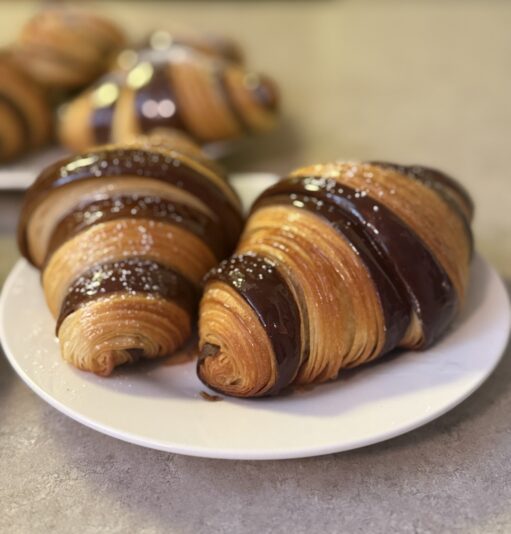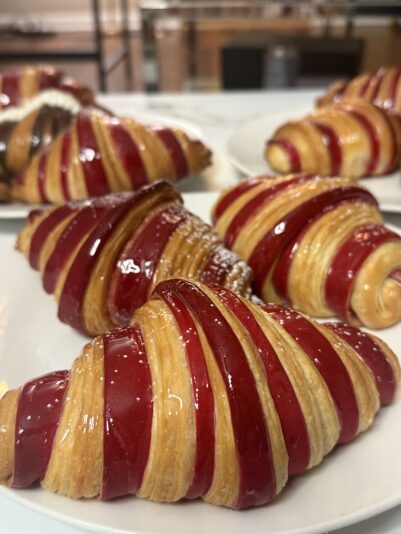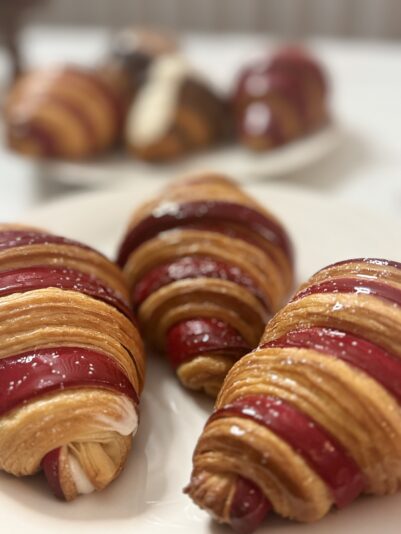Scoolinary › Forums › Ask a question › Croissant layers and inside
-
Croissant layers and inside
Posted by Ivo Coenjaerds on January 20, 2024 at 15:29This is the best result of my first batch. Best result so far. Proofed them a little lower in temperature and a little bit longer and preheated the oven a little higher so the temperature doesn’t drop too low when I put them in.
Only things left to solve:
1. If you look closely in the picture of both croissants you can see the layers don’t touch eachother. It’s more like a spring. Like with a gap between the layers (you can see if you zoom in).
2. The inside is still a bit spongy. I don’t if that is because the dough and butter was too warm during lamination, or I should bake higher temperature? Or something else? All advice is welcome!
Sussan Estela Olaya replied 5 months, 4 weeks ago 5 Members · 11 Replies -
11 Replies
-
Level:
Scoolinary Team
Hi Ivo
Great, we are happy to hear about each of your progress in making the croissant.
I think that indeed the temperature of the butter and dough is a fundamental point in laminating the croissant.
As a personal experience, I always start by baking the croissant at a high temperature so that in those first minutes the layers of puff pastry separate and then lower the temperature so that it can cook inside.
You can try to do it this way. We are going to wait for the opinion of our colleagues so that they can help you with more information.
Greetings.
-
-
Level:
Scoolinary Team
Hi Cary
As I explained above, I do it because being a thermal shock helps the layers of the laminate to separate easily. Then I lower the temperature to continue with the internal cooking of the croissant.
I have been using this method for a long time and it is the one that works best for me.
There are many ways to bake or make a croissant, that “technique” works for me.
Greetings.
-
-
Hi Sussan,
May you please share your way of baking croissants? What is the high temp you’re baking them at first, for how long and when you turning down the temperature?
Many thanks
-
Level:
Scoolinary Team
Hi Salma.
I start by preheating the oven for 25 to 30 minutes, then I place the croissants inside and bake them at 200°C (392°F) for the first 10-15 minutes. This helps the croissants rise quickly and achieve a good texture.
After the first 10-15 minutes, I usually reduce the temperature to 180°C (356°F) and continue baking for another 10-15 minutes, or until they are golden brown and cooked through.
This is the method I have always used to make croissants, and it works for me, but that doesn’t mean it will work for everyone. That’s why it’s important to do a little test to see if it suits the results you’re looking for.
It’s important to keep an eye on the baking process, as the exact time may vary depending on the size of the croissants and the oven you are using.
Best regards.
-
Thank you so much. I’ll try your method, but see even in the images again the outer looks ok, however when freshly cooked and cut in half the inner is not as perfect as it should be, didn’t see much flaky texture, moister, but the next day though I can see some honeycomb only on the larger rings…is the honeycomb should be appealing when freshly baked right?
-
Level:
Scoolinary Team
Hi Salma.
That’s correct; the honeycomb should be visible throughout the entire interior, not just in the larger layers.
As I mentioned before, there are many factors that influence the final result of the croissant, so this is a technique that you achieve through trial and error. You’ll see that you’ll soon master the technique for making croissants.
Best regards.
-
Level:
Scoolinary Team
Hey there Salma!👋
Welcome to the Scoolinary Community! 😊Join our awesome group of food lovers and share your love of cooking. Everyone’s invited!
I’m Sol Damiani, the Community Builder and I’m from Buenos Aires.
I hope Sussan’s answer helped you. Please tell us and show us how it turns out next.
This is a Community that values your participation a lot: that’s why we created “Masters Game”
-
Win Scoolipoints by sharing a pic of your own dishes in our Community > Social Feed section. If it is really cool you can snag a #ScooliStar: you’ll win 100 Scoolipoints and we’ll give you a shoutout on social media!🤩
-
🏆Check out our Challenges and score 250 Scoolipoints! Right now we have the #HalloweenChallenge going on. You’ve got until October 31st at 11:59 PM CET to join.
-
You’ll see everything you need to know about how to win Scoolipoints here.
Let’s build a community of foodies together.
We hope you have a blast learning with Scoolinary!
-
-
Level:
Scoolinary Team
Hi Salma.
Ideally, you should let the bread cool before cutting it. If you cut into a croissant right out of the oven, it’s still moist inside and the layers might still be weak. Cutting it while it’s too hot can cause you to lose some of the honeycomb structure.
From the outside, your croissants look spectacular with a beautiful presentation.
If you’re still having trouble getting that characteristic honeycomb texture, it’s most likely an issue with the lamination. We encourage you to keep practicing—you’re almost there! One more attempt and you’ll see it come out much better.
-
-
-
Level:
Scoolinary Team
Hi Salma
As I mentioned earlier, I’ve been using those temperatures to bake croissants for a while, and they work well in my oven. I use an internal oven thermometer because I don’t fully trust the temperature gauge on my oven’s selector knob.
I would recommend using an internal thermometer if you don’t already have one. It’s the best way to ensure that you’re baking at the correct temperature.
You could try baking at 375°F for 5 minutes and then lowering it to 365°F for an additional 10 to 15 minutes. I think 400°F is too high for baking croissants.
Let us know how it goes as you adjust the oven temperature.
Best regards
-
-
-
-
Log in to reply.








